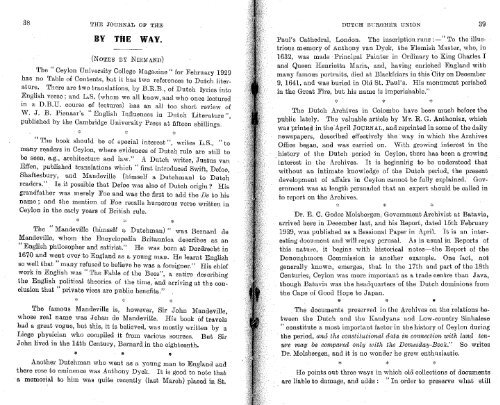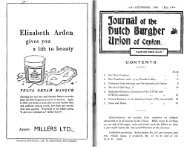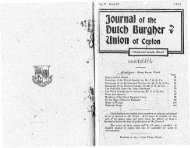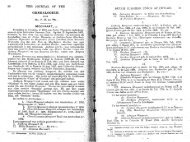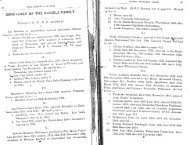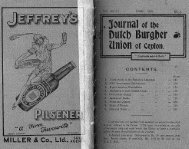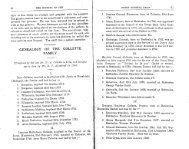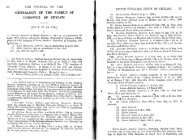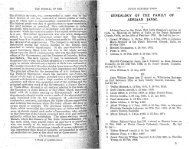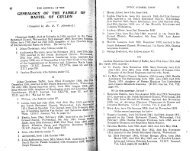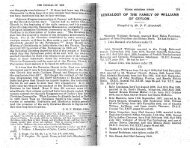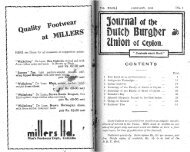Journal of the - Dutch Burgher Union of Ceylon
Journal of the - Dutch Burgher Union of Ceylon
Journal of the - Dutch Burgher Union of Ceylon
You also want an ePaper? Increase the reach of your titles
YUMPU automatically turns print PDFs into web optimized ePapers that Google loves.
38 THE JOURNAL OP THE<br />
BY THE WAY.<br />
(NOTES BY NIEMAND)<br />
The " <strong>Ceylon</strong> University College Magazine " for February 1929<br />
has no Table <strong>of</strong> Contents, but it has two references to <strong>Dutch</strong> literature.<br />
There are two translations, by B.E.B., <strong>of</strong> <strong>Dutch</strong> lyrics into<br />
English verso ; and L.8. (whom we all know, and who once lectured<br />
m a D.B.TJ. course <strong>of</strong> lectures) has an all too short review <strong>of</strong><br />
W. J. B. Pienaar's "English Influences in <strong>Dutch</strong> Literature",<br />
published by <strong>the</strong> Cambridge University Press at fifteen shillings.<br />
"The book should be <strong>of</strong> special interest", writes L.S., "to<br />
many readers in <strong>Ceylon</strong>, where evidences <strong>of</strong> <strong>Dutch</strong> rule are still to<br />
be seen, e.g., architecture and law." A <strong>Dutch</strong> writer, Justus van<br />
Effen, published translations which " first introduced Swift, Defoe,<br />
Shaftesbury, and Mandeville (himself a <strong>Dutch</strong>man) to <strong>Dutch</strong><br />
readers." Is it possible that Defoe was also <strong>of</strong> <strong>Dutch</strong> origin ? His<br />
grandfa<strong>the</strong>r was merely Foe and was <strong>the</strong> first fco add <strong>the</strong>-De to his<br />
name ; and <strong>the</strong> mention <strong>of</strong> Foe recalls humorous verse written in<br />
<strong>Ceylon</strong> in <strong>the</strong> early years <strong>of</strong> British rule.<br />
* w *<br />
The " Mandeville (himself a <strong>Dutch</strong>man) " was. Bernard de<br />
Mandeville, whom <strong>the</strong> Encyclopedia Britannica describes as an<br />
" English philosopher and satirist," He was born at Dordrecht in<br />
1670 and went over to England as a young man. He learnt English<br />
so well that " many refused to believe he was a foreigner." His chief<br />
work in English was " The Fable <strong>of</strong> <strong>the</strong> Bees", a satire describing<br />
<strong>the</strong> English political <strong>the</strong>ories <strong>of</strong> <strong>the</strong> time, and arriving at <strong>the</strong> conclusion<br />
that " private vices are public benefits."<br />
The famous Mandeville is, however, Sir John Mandeville,<br />
whose real name was Jehan de Mandeville. His book <strong>of</strong> travels<br />
had a great vogue, but this, it is believed, was mostly written by a<br />
Liege physician who compiled it from various sources. But Sir<br />
John lived in <strong>the</strong> 14th Century, Bernard in <strong>the</strong> eighteenth.<br />
» ■ » *<br />
Ano<strong>the</strong>r <strong>Dutch</strong>man who went aa a young man to England and<br />
<strong>the</strong>re rose to eminence was Anthony Dyck. It is good to note that<br />
a memorial to him was quite recently (last March) placed in. St,<br />
DUTCH BUBGHER USION 39<br />
Paul's Ca<strong>the</strong>dral, London. The inscription runs :— To <strong>the</strong> illus- ■<br />
trious memory <strong>of</strong> Anthony van Dyck, <strong>the</strong> Flemish Master, who, in<br />
1632, was made Principal Painter in Ordinary to King Charles I<br />
and Queen Henrietta Maria, and, having enriched England with<br />
many famous portraits, died at Blaekfriars in this City on December<br />
9, 1641, and was buried in Old St. Paul's. His monument perished<br />
in <strong>the</strong> Great Fire, but his name is imperishable."<br />
;;: * t'f<br />
The <strong>Dutch</strong> Archives in Colombo have been much before <strong>the</strong><br />
public lately. The valuable article by Mr. E. G. Anfchonisz, which<br />
was printed in <strong>the</strong> April JOURNAL, and reprinted in some <strong>of</strong> <strong>the</strong> daily<br />
newspapers, described effectively <strong>the</strong> way in which <strong>the</strong> Archives<br />
Office began, and was carried on. With growing interest in <strong>the</strong><br />
history <strong>of</strong> <strong>the</strong> <strong>Dutch</strong> period in <strong>Ceylon</strong>, <strong>the</strong>re has been a growing<br />
interest in <strong>the</strong> Archives. It is beginning to be understood that<br />
without an intimate knowledge <strong>of</strong> <strong>the</strong> <strong>Dutch</strong> period, <strong>the</strong> present<br />
development <strong>of</strong> affairs in <strong>Ceylon</strong> cannot be fully explained. Government<br />
was at length persuaded that an expert should be called in<br />
to report on <strong>the</strong> Archives.<br />
Dr. E. C. Godee Molsbergen, Government Archivist at Batavia,<br />
arrived here in December last, and his Beport, dated 15th February<br />
1929, was published as a Sessional Paper in April. It is an interesting<br />
document and will repay perusal. As is usual in Beports <strong>of</strong><br />
this nature, it begins with historical notes—<strong>the</strong> Beport <strong>of</strong> <strong>the</strong><br />
Donoughmore Commission is ano<strong>the</strong>r example. One fact, not<br />
generally known, emerges, that in <strong>the</strong> 17th and part <strong>of</strong> <strong>the</strong> 18th<br />
Centuries, <strong>Ceylon</strong> was more important as a trade centre than Java,<br />
though Batavia was <strong>the</strong> headquarters <strong>of</strong> <strong>the</strong> <strong>Dutch</strong> dominions from<br />
<strong>the</strong> Cape <strong>of</strong> Good Hope to Japan.<br />
# s »<br />
The documents preserved in <strong>the</strong> Archives on <strong>the</strong> relations between<br />
<strong>the</strong> <strong>Dutch</strong> and <strong>the</strong> Kandyans and Low-country Sinhalese<br />
" constitute a most important factor in <strong>the</strong> history <strong>of</strong> <strong>Ceylon</strong> during<br />
<strong>the</strong> period, and <strong>the</strong> constitutional data in connection with land tenure<br />
may be compared only with <strong>the</strong> Domesday-Book." So writes<br />
Dr. Molsbergen, and it is no wonder he grew enthusiastic,<br />
* * *<br />
He points, out'three ways in which old collections <strong>of</strong> documents<br />
are liable to damage, and adds: " In order to preserve what still


